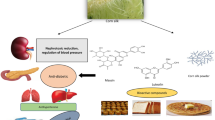Abstract
Pulque is made by fermenting the agave sap or aguamiel of Agave atrovirens with a whole array of microorganisms present in the environment including several lactic acid bacteria and yeasts such as Saccharomyces cerevisiae. Ascorbic acid was determined in pulque and aguamiel, respectively. Phytase activity in lees, liquid and freeze-dried pulque was assayed by measuring the appearance of phosphate from phytate by a colorimetric method likewise phosphate from phytate present in fresh corn tortilla was measured after in vitro incubation with pulque. Iron, zinc, calcium, magnesium and selenium contents were measured in pulque and corn tortilla as well as in nixtamalized corn flour (NCF), the latter is used to make instant tortilla, since corn provides most of the energy as well as most of the phytate in the Mexican rural diet. Pulque showed phytase activity but much less ascorbic acid and iron than previously reported; additionally, phytase in pulque hydrolyzed most of phytate’s corn tortilla. Lees, which is mostly made of pulque’s microbiota, significantly accumulated iron and zinc but no selenium. NCF was fortified with iron by the manufacturers but poorly blended. There were significant differences on selenium content between tortillas samples, apparently some soils in central Mexico are selenium deficient. Moderate pulque intake appears to increase the bioavailability of iron and zinc bound by phytate in corn.
Similar content being viewed by others
Abbreviations
- NCF:
-
Nixtamalized corn flour
- Pi:
-
inorganic phosphate
References
Gonçalves de Lima O (1978) El maguey y el pulque en los códices mexicanos, 2a edición. Fondo de Cultura Económica, México, pp 32–33, 80
Sanchez-Marroquin A, Hope P (1953) Fermentation and chemical composition studies of some species. J Agric Food Chem 1:246–249, doi:10.1021/jf60003a007
Backstrand JR, Allen LA, Martinez E, Pelto GH (2001) Maternal consumption of pulque, a traditional central Mexican alcoholic beverage: relationship to infant growth and development. Public Health Nutr 4:883–891, doi:10.1079/PHN2001130
Backstrand JR, Allen LA, Black AK, de Mata M, Pelto GH (2002) Diet and iron status of nonpregnant women in rural Central Mexico. Am J Clin Nutr 76:156–164
Hallberg L, Rossander L, Skanberg A-B (1987) Phytates and the inhibitory effect of bran on iron absorption in man. Am J Clin Nutr 45:988–996
Oberleas D, Muherer ME, O’Dell BL (1966) Dietary metal-complexing agents and zinc availability in the rat. J Nutr 90:56–62
Heaney RP, Weaver CM, Fitzsimmons ML (1991) Soybean phytate content: effect on calcium absorption. Am J Clin Nutr 53:745–747
Bohn T, Davidsson L, Walcyzyk T, Hurrell RF (2004) Phytic acid added to white-wheat bread inhibits fractional apparent magnesium absorption in humans. Am J Clin Nutr 79:418–423
Sanchez-Marroquin A, Larios C, Vierna L (1967) Estudios sobre la microbiología del pulque XIX. Elaboración de la bebida mediante cultivos puros en planta piloto. Rev Latinoam Microbiol Parasitol (Mex) 9:83–85
Vohra A, Satyanarayana T (2003) Phytases: microbial sources, production, purification, and potential biotechnological applications. Crit Rev Biotechnol 23:29–60, doi:10.1080/713609297
Tovar LR, Larios-Saldaña A (2005) Iron and zinc fortification of corn tortilla made either at the household or at industrial scale. Int J Vitam Nutr Res 75:142–148, doi:10.1024/0300-9831.75.2.142
Levander OA (1996) Selenium. In: World Health Organization (ed) Trace Elements in Human Nutrition and Health. World Health Organization, Geneva, pp 105–122
Keck A-S, Finley JW (2006) Databases values do not reflect selenium contents of grain, cereals, and other foods grown or purchased in the upper Midwest of the United States. Nutr Res 26:17–22, doi:10.1016/j.nutres.2005.11.009
Cravioto RO, Anderson RK, Lockhart EE, Miranda FP, Harris R (1945) Nutritive value of the Mexican tortilla. Science 102:91–93, doi:10.1126/science.102.2639.91
AOAC (2005) Official methods of analysis, 18th edn. Association of Official Analytical Chemists, Gaithersburg
Fiske CH, Subbarow Y (1925) The colorimetric determination of phosphorous. J Biol Chem 66:375–400
Campbell AD (1992) A critical survey of hydride generation techniques in atomic spectroscopy. Pure Appl Chem 64:227–244, doi:10.1351/pac199264020227
Institute of Medicine (2000) Dietary Reference Intakes for Vitamin C, Vitamin E, Selenium, and Carotenoids. National Academy of Sciences, Washington, D.C., p 506
Shieh TR, Ware JH (1968) Survey of microorganisms for the production of extracellular phytase. Appl Environ Microbiol 16:1348–1351
Lei XG, Stahl CH (2001) Biotechnological development of effective phytases for mineral nutrition and environmental protection. Appl Microbiol Biotechnol 57:474–481, doi:10.1007/s002530100795
Hernández M, Chavez A, Bourges H (1977) Valor nutritivo de los alimentos mexicanos. Instituto Nacional de la Nutrición, México, pp 19–20
Instituto Nacional de Salud Pública (2001) Encuesta Nacional de Nutrición 1999. Estado nutricio de niños y mujeres en México, Cuernavaca, pp 185–186
Sandberg A-S, Andersson H (1988) Effect of dietary phytase on the digestion of phytate in the stomach and small intestine of humans. J Nutr 118:469–473
Mendoza C, Viteri FE, Lönnerdal B, Young KA, Raboy V, Brown KH (1998) Effect of genetically modified, low phytic acid maize on absorption of iron from tortillas. Am J Clin Nutr 68:1123–1127
Hallberg L, Brune M, Rossander L (1989) Iron absorption in man: ascorbic acid and dose-dependent inhibition by phytate. Am J Clin Nutr 49:140–144
Charlton RW, Jacobs P, Seftel HC, Bothwell TH (1964) Effect of alcohol on iron absorption. Br J Med 2:1427–1429
Ramirez-Bribiesca JE, Tortora JE, Huerta M, Aguirre A, Hernandez LM (2001) Diagnosis of selenium status in grazing dairy goats on the Mexican plateau. Small Rumin Res 41:81–85, doi:10.1016/S0921-4488(01)00188-2
Acknowledgments
Two of us, LRT and MEG, are fellows from the Commission for the Promotion of Academic Activities, an organization that belongs to the National Polytechnic Institute. We appreciate the reviewers’ comments on this article.
Author information
Authors and Affiliations
Corresponding author
Rights and permissions
About this article
Cite this article
Tovar, L.R., Olivos, M. & Gutierrez, M.E. Pulque, An Alcoholic Drink from Rural Mexico, Contains Phytase. Its in vitro Effects on Corn Tortilla. Plant Foods Hum Nutr 63, 189–194 (2008). https://doi.org/10.1007/s11130-008-0089-5
Published:
Issue Date:
DOI: https://doi.org/10.1007/s11130-008-0089-5




